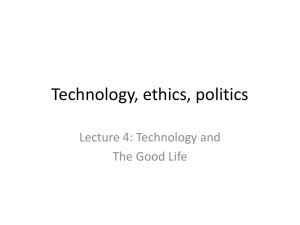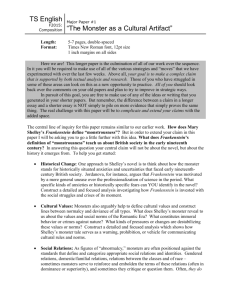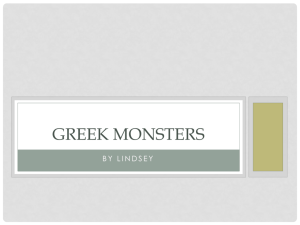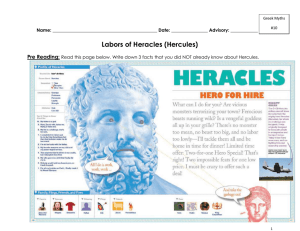Ancient Greek Monsters - Red Hook Central School District
advertisement
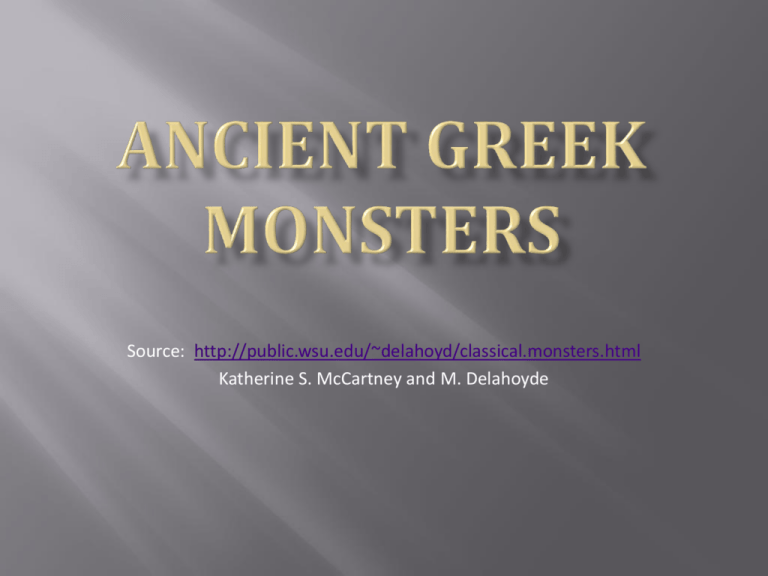
Source: http://public.wsu.edu/~delahoyd/classical.monsters.html Katherine S. McCartney and M. Delahoyde Monsters in classical mythology are typically part animal and part human, or else they constitute a collection of animal graftings. They are not really horror monsters, just unpleasant or nasty afflictions sent by the gods. They often do no more than throw into relief the heroism of the protagonist (e.g., Perseus, Oedipus, Odysseus, Theseus) by existing simply to be overcome or destroyed as obstacles to his goal. In modern monster stories, conversely, heroes are boring and draw little interest whereas we remember the monster. It is the monster who lives on and who even lends its name to the story (e.g., Dracula, The Mummy, The Wolf Man, The Blob, etc.). Insofar as monsters manifest the polar opposites of what a culture values, the fact that the classical monsters are deviations from the "classical" human form is telling. Greek and Roman culture is known for its sculpture of what has become the ideals of male and female beauty. Naturally its monsters diverge from this. Distortion from or violation of the cultural ideal is what defines them as monsters. Cerberus is the watchdog of the realm of Hades, generally described as being a three-headed dog with a serpent tail, and on his back innumerable snakes' heads. He is believed to be the son of Echidna and Typhon, brother of Orthrus, the monstrous dog of Geryon, of the Hydra of Lerna, and of the Nemean lion. Chained in front of the gates of the Underworld, he terrorizes souls upon their entering. You can catch a glimpse of him in Virgil's Aeneid, Book VI (Aeneas' journey into the underworld) and in Dante's Inferno. In other stories, Cerberus was bested by men such as Heracles and Orpheus. He stops barking if you throw him some bread soaked in wine. "To give a sop to Cerberus" means to present someone who is likely to cause trouble with a gift in order to keep him quiet, but this works best on dogs. Considered savage and violent, these beings are half man and half horse. The live in the mountains and forests, their food is raw flesh, and their behavior is bestial. The centaurs are known for their drunkenness and lust and are often portrayed as followers of Dionysus, god of wine. Two centaurs, Chiron and Pholus, were not the brutal beasts as their lineage destined, but rather were hospitable, charitable, and loved their fellows, shunning violence. Centaurs are known for their battling against Heracles and were featured in some legends concerning abductions. Nessus had given Dejanira, the wife of Heracles, a small bottle filled with his own blood, telling her that if she ever found that her husband ceased to love her, she could restore his affection by using it. However, this blood was poison to the touch and in some legends destroyed Heracles. A version of this story can be found in Ovid's Metamorphoses. Satyrs had the head and upper body of people, but the lower body of a goat. The Roman name for satyrs was fauns. Pan was the leader of the satyrs and the god of shepherds. This monster is a legendary beast taking its shape from both a goat and a lion. Some stories say that it had the hindquarters of a snake and the head of a lion on the body of a goat. Others claimed that it had two heads, one goat and one lion, and it breathed fire. The king of Lycia, Iobates, commanded Bellerophon to kill it since the monster made many raids on his kingdom; with the help of Pegasus, the winged horse, Bellerophon succeeded. The Chimaera often appears in architecture, although the monster is usually greatly changed from the form known to classical mythology. These beings are giants with one enormous eye in the middle of their forehead. In Hesiod, the three sons--Arges, Brontes, and Steropes--of Uranus and Gaea, the personifications of heaven and earth, were Cyclopes. They were thrown into the underworld by their brother Cronus, one of the Titans, after he dethroned Uranus. Zeus released the Cyclopes from the underworld and they gave him the gifts of thunder and lightning. In Alexandrine poetry, the Cyclopes were considered merely as subordinate spirits: smiths and craftsmen who made the weapons for the gods. They forged Zeus' lightning bolts. In Homer's Odyssey, the Cyclopes are shepherds from Sicily. They are lawless, savage and cannibalistic. They fear neither gods nor humans. Harpies are birds with the heads of women, long claws, faces pale with hunger, and they leave behind filth and stench. They were originally sent by Zeus/Jove to torment a blinded soothsayer, Phineas. This monster was also the spawn of Echidna and Typhon, a snake with numerous heads that were sometimes said to be human as well. It was brought up near the source of the river Amymone in order to provide a test for Heracles. The breath of the Hydra was so venomous that anyone who approached it would die, even if the monster was sleeping. Heracles thought to destroy it by cutting off its heads, but as soon as he did so more heads grew in their place. Therefore Heracles seared the bleeding necks of the monster with a torch in order to prevent growth that way. According to some legends one of the heads was immortal, but Heracles cut it off anyway and buried it deep in the earth. Heracles also dipped his arrowheads in the Hydra's blood and made them extremely poisonous. The term hydra is commonly applied to any complex situation or problem that continually poses compounded difficulties. Somewhat vampirical, this was a female monster who was thought to steal children and drink their blood. She was thought to have a woman's head and breasts, but a serpent's body. In some accounts she was one of Zeus' lovers who bore him children. Hera, in fits of jealousy, caused each child that was born to die. In despair, Lamia became a monster jealous of mothers more fortunate than herself. So she devoured their children. Female spirits which attached themselves to children in order to suck their blood were also called Lamiae. Once a beautiful woman, Medusa was the child of Phorcys and Ceto. Of the three sisters, the gorgons, Medusa was the only mortal. Their hair was a mass of serpents; they had huge tusks, hands of bronze, and golden wings enabling them to fly. Anyone who encountered their gaze was turned to stone immediately from a horrible fear and loathing. Poseidon was the only immortal not fearful of Medusa since he fathered a child with her. Medusa was defeated by Perseus, who managed to chop off her head by looking at her through a looking-glass, which was most likely a bronze shield. This story can be found in Ovid's Metamorphoses. Athena made use of Medusa's head by fixing it to the center of her shield or her aegis. People of today sometimes call a person a gorgon, meaning that her aspect is so stern and forbidding that it almost turns one to stone. The Minotaur was a beast that had the body of a man and the head of a bull. Legend has it that King Minos of Crete tried to cheat Poseidon by begging for a beautiful white bull for sacrifice to the gods. However, when Minos got hold of this bull he put it in with his own herds. Very angry, Poseidon caused Minos' wife to fall in love with the bull and become its lover. The Minotaur was the result of this weird union. The Labyrinth was built in order to house the beast and each year he was fed with seven boys and seven girls who were the tribute exacted by Minos from Athens. Theseus was able to defeat the Minotaur with the help of Ariadne, King Minos' daughter. She gave him a skein of thread and a sword so that he might kill the monster and then retrace his steps back through the labyrinth. The horrendous lion was killed by Heracles. Hera raised the lion and set it in the region of Nemea, where it ravaged the land, devoured people, and ate the herds. The legends state that no weapon could penetrate the lion's pelt. Therefore, Heracles strangled the lion in the cave it lived in and flayed it. He then clad himself in its skin and used the head as his helmet. This monster was said to have the face of a woman; the chest, feet, and tail of a lion; and wings of a bird. This monster was sent to Thebes by Hera to punish the city for the crime of Laius, who had been guilty of loving Pelops' son. The Sphinx devoured every mortal who passed by within reach, but it would ask passers-by this riddle: "What is it that has four feet in the morning, two at noon, and three at night?" If they couldn't solve the riddle they died. Only Oedipus was able to solve it: humans crawl on all fours in infancy, attain bipedal status, and late in life walk with a cane. In despair the Sphinx threw itself from the top of a rock and killed itself. In ancient Egypt, sphinxes were statues representing deities, with the body of a lion and the head of some other animal or of man, frequently a likeness of the king. 1. What similarities do you see with the ancient Greek monsters? 2. Are there ways you would group / categorize them? 3. For each of the groups that you see, why do you think the ancient Greeks concentrated on these groups? There are several common denominators among the mythological monsters. Except for the Cyclopes, each monster described above has one or more appendages from various types of animals. The most prominent animal appendage, however, was the serpent. Each time the serpent was seen as a physical influence, it shot horrible fear through the hearts of those that challenged the monster as well as those the monster ravaged. Could it be that the serpent showed how fearful the Greeks and Romans were towards the gods? When Heracles battled the Hydra, it was interpreted that the hydra with the heads that renewed themselves was in reality the marsh of Lerna, which was drained by Heracles. The heads represented the springs which always seeped back, making Heracles' efforts useless (Grimal 197). Throughout the centuries, the serpent has generally symbolized some sort of evil, whether monstrous, as in Greek and Roman mythology, or as the symbol of the devil, as in Christianity. The lion is another animalistic feature present within many of the monsters. This could possibly depict savagery and a hunger for blood from the hunt. These beings were considered monstrous because not only did they have animalistic appendages, they also were brutally savage and loved the kill. This savagery and brutality could signify a fear of pagans, cannibals, and uncivilized people--even the uncivilized urges within us. The monsters typically are a test from the gods or a punishment. But why animals? Why not someone who had such magic that a spell could destroy people in a puff of smoke? Perhaps because people feared more that which was tangible to them, like a being with the body of a man and a head of a bull. People are afraid of the animalistic nature within them because it makes them uncivilized. The beings with mixed animal and human appendages were savage and uncivilized. The monsters depicted pure animalistic nature, which civilized human beings received with disgust and revulsion. The gods perhaps chose animalistic beings as tests for the humans because the animals are the closest in species to the humans but still distant enough to be unknowable. http://www.youtube.com/watch?v=fnAJy5ITWME Harpy (fury) in Percy Jackson and The Lightning Thief http://www.youtube.com/watch?v=eLpPDAQ0Z3s Pan’s Labyrinth (satyr) http://www.youtube.com/watch?v=6kguwhKq30I Perseus vs. the Minotaur – Wrath of the Titans http://www.youtube.com/watch?v=VhLScMxedXI Harry Potter and the Sorcerer’s Stone – Cerberus http://www.youtube.com/watch?v=k5OERqTniro The Odyssey - Cyclopes http://www.youtube.com/watch?v=akg77QqDPYI Percy Jackson and the Lightning Thief – Hydra
